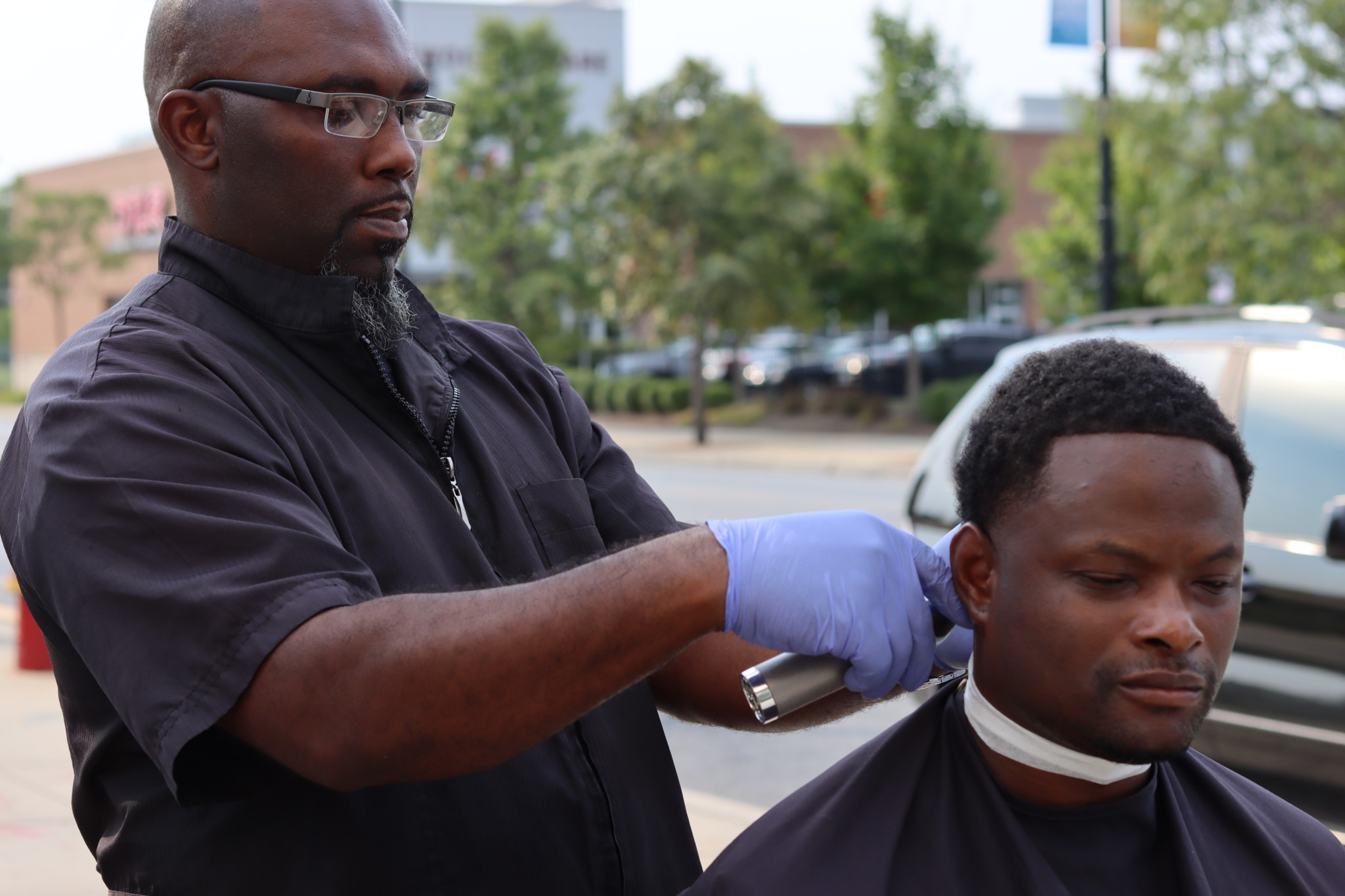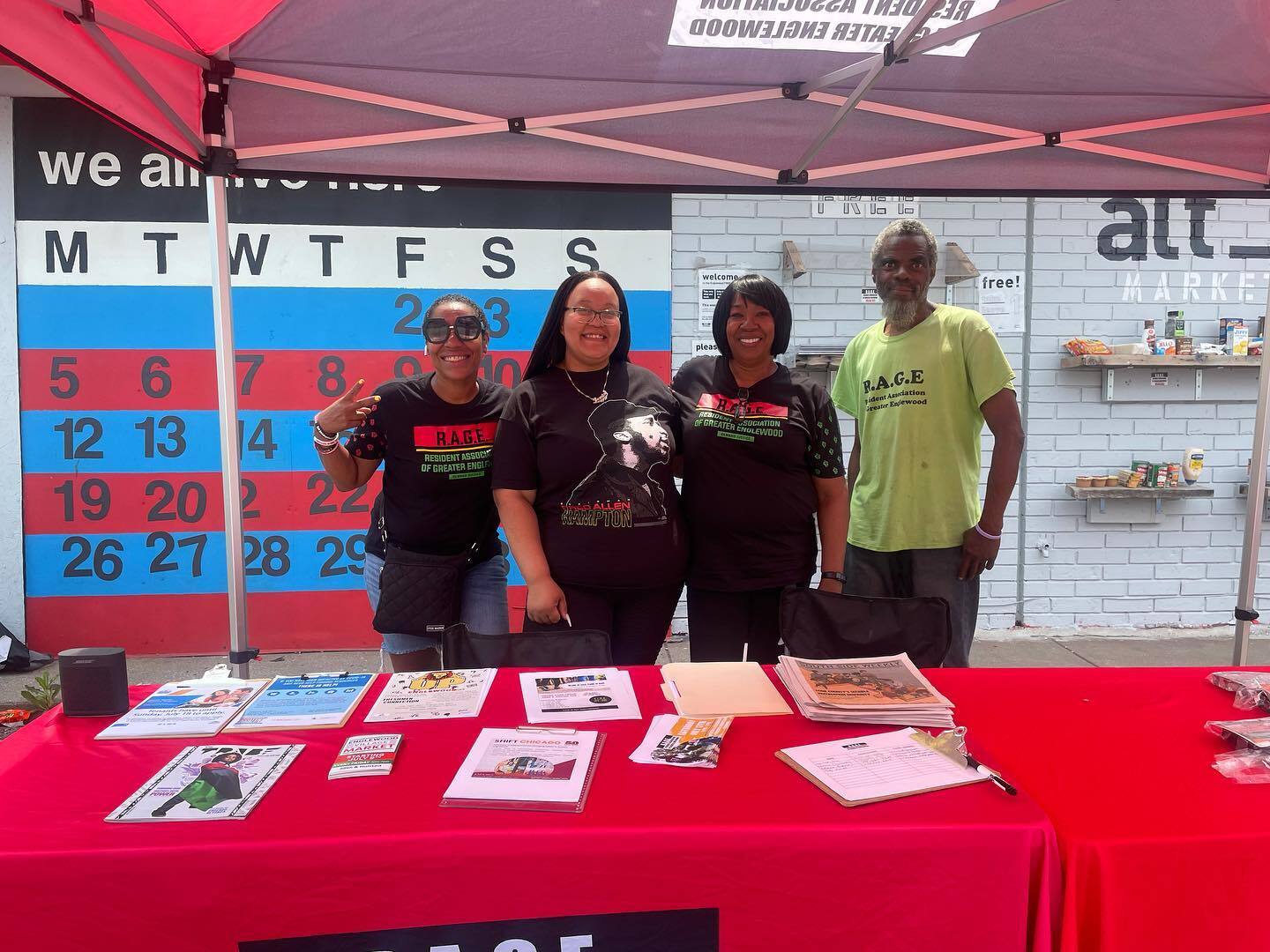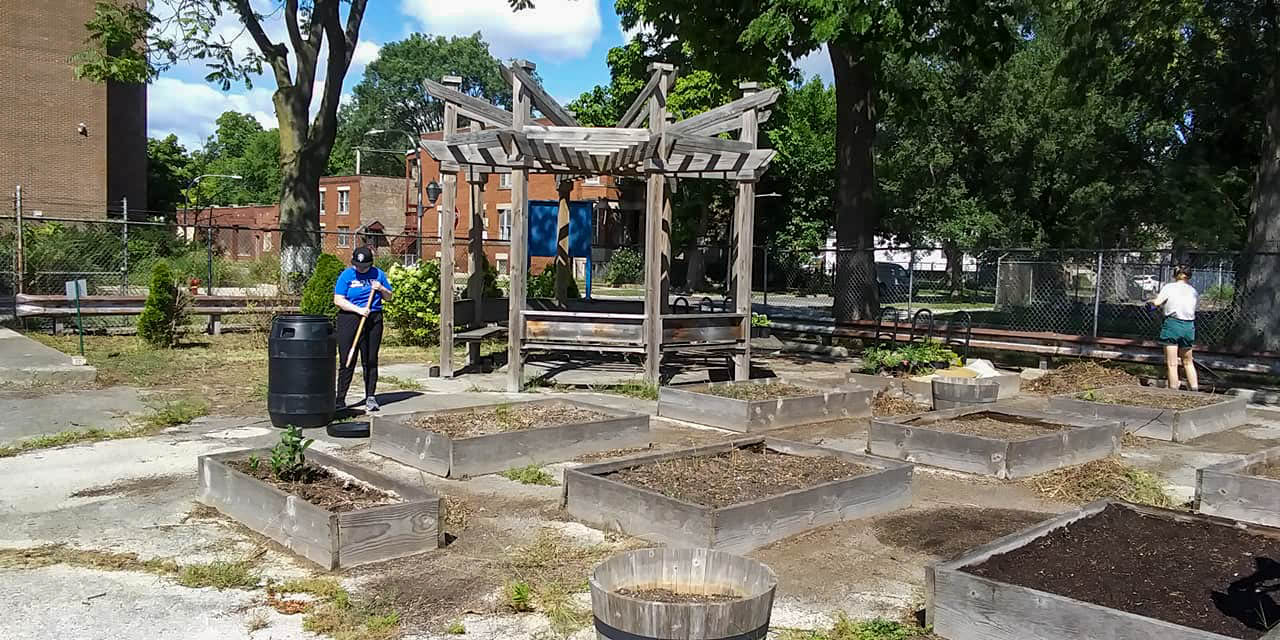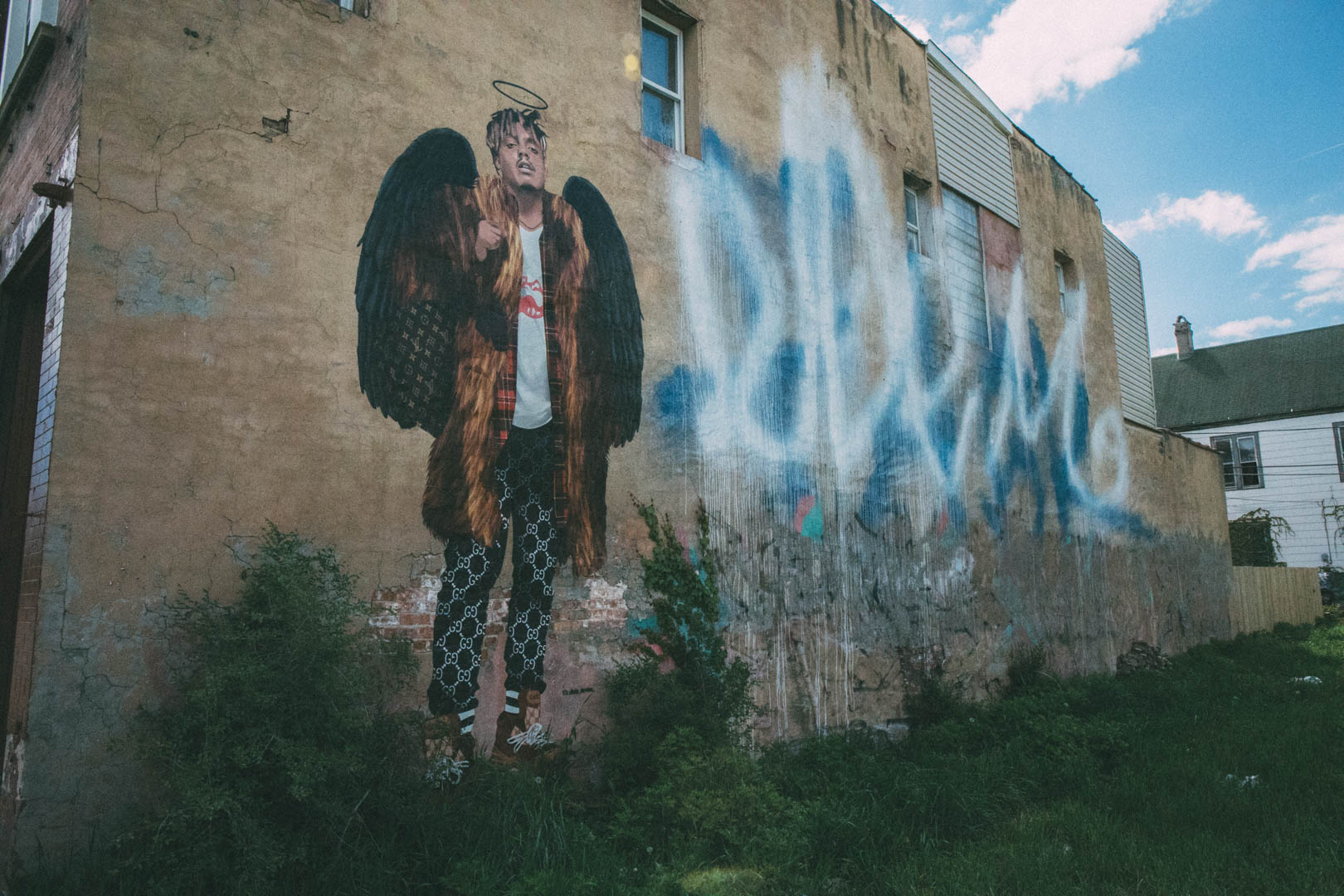It was October 1981, and already Chicago-chilly, as my mom and I walked the four blocks to the 79th and Vincennes bus stop to ride to my grandparents’ new home. The first bus rode up Vinncenes past McDonald’s and the famous Fred and Jack’s toward 75th, where we did a light jog to transfer to the 75th Street bus. The driver greeted us, said something about it getting cold out there, and waited for us to take our seats. It was a short ride to the corner of 74th and Halsted. We walked one block east of Halsted to arrive at 74th and Emerald.
I spent most of the bus ride trying to understand why my grandparents had left what I called, “the palace.” Their huge, maybe 1,400-square-foot apartment with high ceilings on Michigan seemed majestic to me. The white walls seemed chalky white compared to the high-gloss paint used now. There were three bedrooms and one big white bathroom. It had a long hallway and a bathroom with two doors, one door leading to my grandmother’s bedroom near the front entrance and the other to what seemed like an unending hallway with entrances to two more bedrooms before you got to the back living room.
In this living room, I could turn myself around without the fear of breaking any of Granny’s decorative items or framed family photos. I would turn and turn around until I was dizzy and in a pile on the floor. I only gained my composure to start all over again. In the palace, there was room for Friday night fish fries, card parties, and Sunday dinners with friends and family in the afternoon. But the best part was the front room.
Built into the wall beneath a high ceiling and embedded in crown molding was a “built-in mirror.” To this day it is where I have given my best singing and acting performances. I gave an emotional rendition of Billy Joel’s “Just the Way You Are” and recited lines from The Wiz and Pearlie Victorious, and sang “Papa don’t take no mess” as good as James Brown. This journey to the new home was a wonder and curiosity. How could my Granny and Grandaddy leave the palace for home “ownership?”
I was eleven years old when I turned off 74th onto Emerald. As I walked down the street there were still kids out at 3pm on a Saturday, playing ball and sitting on the porch. Breaking up the sky, as if to frame the block, I could see a tall viaduct; I didn’t yet know it was a train route: beneath the viaduct there were four yellow-painted concrete posts so cars couldn’t pass through to 75th. On the street, no house or building was the same, but they also weren’t very different. They stood out because of the uniformity of the lawns. They were what adults would call “well-manicured” and the houses did not have fences in the front. Every porch seemed to welcome you to sit down; most had some type of foliage, or you could see huge pots where the flowers had withered as fall began its slow takeover. Even on this frigid day in October, Emerald was paved with concrete but the lawns accented the street like emerald green rugs.
My grandparents’ building was dark brown and the bricks had tan lines between them, with a concrete porch and reflective white numbers on the storm door that read 74XX. The building was two stories with a basement apartment. Both apartments came with tenants that had lived in the building for almost ten years. Granny, Grandaddy, and my uncle lived on the top floor, with one tiny bathroom, a hallway one-third the size of the one at the palace, and a living and dining room that were functional at best. The only fascinating space was the balcony on the front, but you had to climb out the window to use it. Still, I soon exchanged living room concerts for sunrises and soul music on that balcony.
Two weeks later, my mom and I returned with the last of our items to move in as well. Before my foot could competently hit the landing, the bell rang. My mom turned around to answer it and in less than a minute, she called me down. There was a very fair-skinned boy with sandy brown to blonde hair. He had on a green parka with a brown fur hood and was pointing a water gun at me, ordering me to come out and play. I had made my first friend—a friend who would encourage me to take the entry exam to St. Ignatius and support me in my first two years as my friend and math tutor. Because of him, I made honor roll my first and second quarter. He also taught me about HBCUs and supported my application to Xavier University.
We lived on a mixed-income block with different kinds of families. There were senior, middle-aged, and young married couples. There were single mothers. Families were living in the same building as tenants or owners. There were entrepreneurs, blue-collar workers, and folk that stayed home on assistance. Everyone had a role. When my mother wasn’t around my teenage behavior was reined in by many “nosy neighbors.” I owe the preservation of my teenage innocence to someone I will call Ms. V. She could sense a boy headed to your house when your parents were home, and make him disappear into thin air. Her porch presence was as ominous as an eagle circling its prey.
Everyone needs energy, safety, and possibility to thrive, including communities. Energy in communities is about a shared actualized value system. These values may be spoken or unspoken and when these values are challenged their collective consequences are enacted by the community. For example: there was no drug selling on our block. This was unspoken, but anyone attempting to set up shop was shut down immediately. Energy was also demonstrated by our yearly block club parties. As teens and young adults we were valued in our village and were allowed to express ourselves. Parents supported our group events, activities, and parties. No child was left behind. Every child was encouraged. When mothers or fathers met with life challenges, someone on the block covered you. I felt the energy of my community.
My middle school years included bike rides as far as our energy and legs could take us before the streetlights came on. When I came home, I smelled like outdoors and had to take two baths to get clean. In my teen years, it was boomboxes, preppy clothing, and house parties. The kids in my neighborhood went to community schools like Simeon, Roberson, and Lindblom; Whitney Young and St. Ignatius. But we were together. We attended each other’s parties and activities. When I got accepted into St. Ignatius, seven kids from my block met at sunset at Harold’s on Halsted, we ate hot and mild sauce, listened to the jukebox, and opened the envelope together. We celebrated with each other. It was OK to be who you were. I felt safety in my community.
When I walked down my street in Englewood, I was surrounded by Black people doing Black things, running and buying from Black businesses. Before I could walk the block to Halsted there was a Black-owned and operated cleaner. The owner lived on my block. One block over to Halsted and on the east side of 73rd was a Black women-owned and -operated liquor store and lounge. The owner lived in the community. A few doors down was a Black-owned and operated pizza parlor. On the opposite side of the street, there was John’s Groceries, John’s Hardware, and John’s bike shop. There was a Black-owned game room with candy, snacks, and icies. On the same street was a Black-owned lounge owned by a neighbor, and of course we had Harold’s Chicken. I felt possibility in my community.
I have lived in the same home and community intermittently for twenty-nine years. I believe in Englewood and its capacity to sustain energy, safety, and possibility for all its residents. I believe and love Black people in totality and I have raised three free Black children in this community.
I currently serve as the chair of Grow Greater Englewood (GGE). Supporting farming and green spaces in Englewood is essential to addressing the impact of racism in our communities, particularly inequities in food and health. Additionally, I have had the opportunity to visit other Englewood spaces, like St. Peter’s, and experience the effective operation and quality services provided by the food pantry.
Attending the unveiling of Hank Willis Thomas’s “All Power to All People” installation on the grounds of Englewood Village Plaza was the highlight of the summer for me. The installation is essentially a gigantic pick, a symbol of power and beauty. There, I was surrounded by Englewood residents and friends, community business owners, and Black nonprofit leaders. I was standing in that space with my people, outside again, feeling the air, and celebrating what remains when we fight white hegemony, a pandemic, and continue to build our families and communities. As I spoke, I shared that this event was happening at home in the heart of Englewood. At this moment hope was no longer surreal, but felicitous, restorative, actualized. I could feel our collective energy, desire, and need to just be together. It was a good day.
We are Englewood Strong. We are actively working to frame the destiny of our community through strategic partnerships and collective action to ensure Safety, Energy, and Possibility. Ase’. (Atara B. Young)
Best Samaritan
The Street Barber

He stations himself on 63rd near Halsted a few times a month, turns up his speaker, and offers a free haircut to people walking by. Sometimes he’s there for two hours, sometimes for twelve.
David McDonald was a professional barber in Florida for thirty years. He had his own business at one point that was successful, and would even cut celebrities’ hair, like that of Venus and Serena Williams’ father, Richard Williams.
But he and his wife, who are people of faith, got “a calling from God,” he said, and Chicago kept coming up in conversations with friends who they respected in and out of church. Roughly a decade later, the couple made the move to the Midwest.
When I stopped by on Sunday afternoon, McDonald was concentrating on doing a lineup on a young man who was visiting his family in Englewood. Russell McDade grew up in the neighborhood, but moved to Milwaukee because “my mom wanted better choices for us,” he said. He heard about the street barber on Facebook and decided to drive by.
“He’s someone I could talk to if I ever needed to talk. I offered him a tip and he said no. No tips, no nothing,” he mumbled, careful not to move as the trimmer grazed his chin.
McDonald does all types of men’s haircuts when he’s outside: fades, brush cuts, tapers, afros, comb overs, mohawks… After he was done, Russell asked him for a photo. Then an older gentleman sat on the barber’s chair, while a teenager arrived and waited.
Bruce Lee has been coming to McDonald “every Sunday that I catch him,” said the Englewood native, “because people don’t have a lot of money these days. … You know, you go to a barbershop and it’s $20-$25 for a haircut. To do it free is a blessing.”
McDonald said people tried to discourage him from going to the South and West Sides when he first arrived to Chicago two years ago, especially Englewood. But he took that as a sign that those places are where he needed to be.
“They depict it real rough, you know what I’m saying?” Lee said about his neighborhood.
The street barber has been inspired by the reception and wants to do more. As a licensed barber and cosmetology teacher, one of his dreams is to open up a tuition-free school for young people to learn the trade.
His biggest reward, he said, has been connecting with the community. (Jacqueline Serrato)
The Street Barber, corner of W. 63rd St. and S. Halsted St. Sunday afternoons, weather permitting. facebook.com/DavidMcDonaldCuttingEdgeMobility
Best Place to Pick Up Diapers
Englewood Free Market

After the uprisings of 2020, many of Englewood’s stores were boarded up and out of commission for local patrons. This was the case for many of Chicago’s South Side neighborhoods, and beyond the temporary unavailability of services, the boards were eyesores for residents.
What started as an organic conversation between the Resident Association of Greater Englewood (R.A.G.E.), the Englewood Arts Collective, and Alt_, has now evolved into a thriving, self-sustaining community market on 66th and Halsted, called the Englewood Free Market.
A mural was painted on the side of what used to be an In and Out Deli, and more famously, a Church’s Chicken, and it now serves as the bed for outdoor wooden shelves that hold items like food, diapers, and other essential items that are offered free of charge to residents and restocked weekly by local partners and community members.
R.A.G.E. took the opportunity to go above and beyond, also piloting resource days at the market this summer, where residents could come to learn about job opportunities, childcare services, and healthcare providers. The spirit of this effort encompasses so many things, but in R.A.G.E. executive director Asiaha Butler’s words, beauty is at the core: “Even though it’s abandoned and vacant, you can still make it beautiful. And I think that’s what R.A.G.E. has always been about and that’s what we think about our community. It’s been abandoned, it’s been vacant, it’s been stripped [of] tons of resources, but we still find ways to make it beautiful.” (Malik Jackson)
Englewood Free Market, W. 66th St. and S. Halsted St. Open to whoever, whenever.
Best Garden That Could
Englewood Veterans Garden

Since 2015 the Englewood Veterans Garden has relied on referrals from the recreational therapy program at the VA to provide the help that garden leader Cordia Pugh needed to keep things shipshape. According to gardener Ron Stacy, from 2015 to 2019 the garden could reliably count on ten to fifteen veterans to get involved each year, helping plant and weed the raised vegetable beds and tend to maintenance of the space, a former vacant lot on 56th and Hermitage. Then, said Stacy, “2020 happened, and you had COVID. So everybody disappeared.”
Stacy, himself a U.S. Navy veteran, has been volunteering at the garden since its inception, and wanted to stay engaged. It was left to him, Pugh, and her son Leonard to keep both the Veterans Garden and the Hermitage Street Community Garden across the street from falling into weedy disrepair. “It was so hard,” he said. “When I joined the garden, we always had these huge volunteer groups”—first-year college students and church groups—”throughout the spring, the summer, and the fall to make our gardens possible. When COVID hit, we lost those volunteer groups.”
They did “alright” in 2020, Stacy said, but this year was all about changing the way they garden. It was a transitional year, in which—anticipating future years with few volunteers—the trio transformed both gardens to make them lower maintenance. In the persistently weedy ground between all the raised beds, they laid in an underlayer of cardboard or plastic, and then covered that up with wood chips. Voila, no more weeds. “It was a lot of work. It just consumed us, the entire year.” Now, he added, they’re gearing up to completely overhaul their composting setup.
“A lot of what we’re doing now is just to prepare for next year, right? Even if COVID is, is still affecting people’s lives, people are getting more comfortable with doing things and being active again. And being that this is a garden. I think that’s going to be one of the biggest things going to be able to promote is that you’re going to be able to be in a safe environment ‘cause you’re outside.”
He may not have grown much this year—mostly cayenne peppers and kale—but the garden has been key to his mental health, Stacy said. Being able to come to the garden and read or meditate or listen to music was invaluable—which was the whole point of the garden in the first place. And, finally, he might get a little break: the first group of college student volunteers returned this month. (Martha Bayne)
Englewood Veterans Garden, 5641 S. Hermitage Ave. (773) 245-3017.



